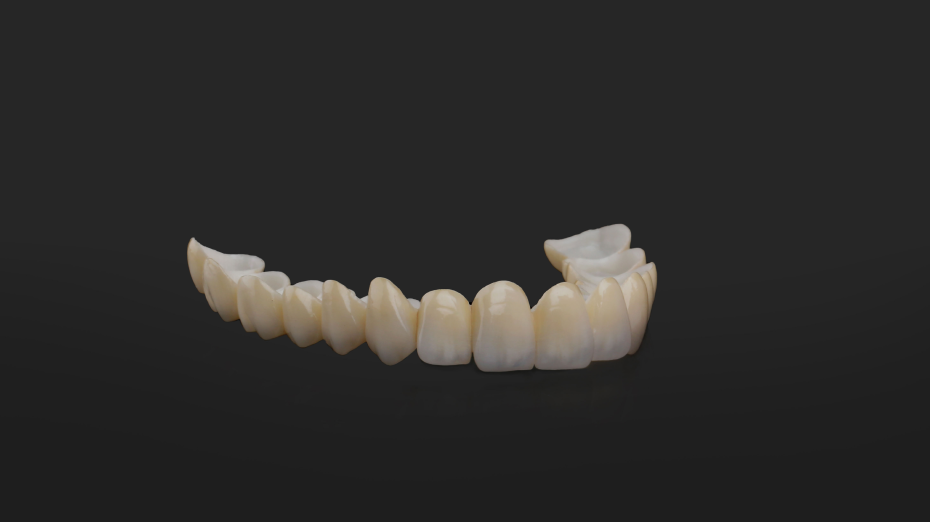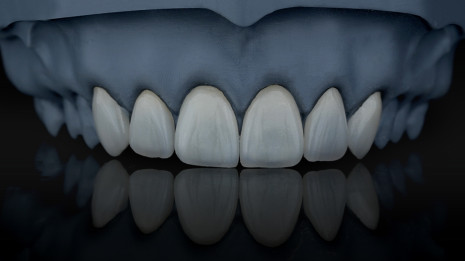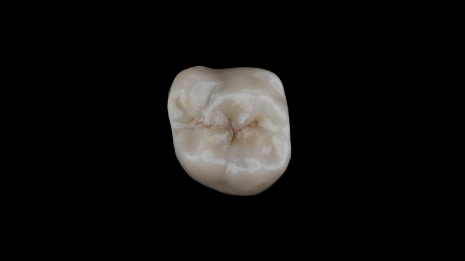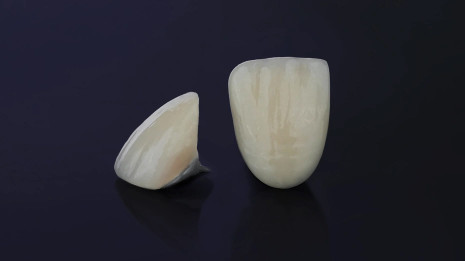Multi-layer zirconia
Five gradient transitions blend strength cores and enamel translucency for full arch rehabilitation.
Includes Ultra Plus, Platinum Plus, Premium Plus and Solid Plus.
Noble Dental Care
ISO certified CAD-CAM • Digital shade mapping • Micron-precision fit
Every crown is designed chairside with intraoral scans, AI occlusion checks and premium Indian CAD-CAM milling so you can review shade, translucency and bite comfort before cementation.
Average margin fit achieved via digital milling verification
Peak flexural strength for posterior zirconia crowns
Express turnaround using in-house scan to seat protocol
Our digital library mirrors the latest product sheets so you can visualise how Ultra Plus, Platinum, Premium, Solid Plus, IPS e.max, 3M Lava Ultimate, printed hybrids and high noble alloys behave in the chair.
Five gradient transitions blend strength cores and enamel translucency for full arch rehabilitation.
Includes Ultra Plus, Platinum Plus, Premium Plus and Solid Plus.Pressed IPS e.max and 3M Lava Ultimate nano-ceramic deliver high fluorescence and incisal clarity for the smile zone.
Ideal for minimal prep veneers, single centrals and layered bridges.Peek frameworks, laser-sintered metal, high noble alloys and printed hybrids handle complex implant and attachment cases.
Shock absorption, soft tissue health and long-span accuracy covered.Watch the multi-layer zirconia workflow straight from our premium laboratory partner – from CAD design to sintering, staining and final glazing – so you know what powers every restoration we deliver.
Preview every crown category with macro images from our premium CAD-CAM partner lab. Tap any card to enlarge the finish, translucency and occlusal anatomy.


.png)







.jpg)
.jpg)



Match crown material to tooth position, flexural strength, reduction requirement and soft-tissue response. All values are reviewed by Dr. Dhivakaran for Noble Dental Care.
| Crown type | Anterior teeth | Posterior teeth | Flexural strength | Indications | Contraindications |
|---|---|---|---|---|---|
| Ultra Plus layered zirconia | Cut-back and porcelain veneering give incisal translucency for centrals. | Monolithic occlusal delivers confidence up to 6-unit bridges. | Up to 1400 MPa | Anterior/posterior hybrid cases requiring strength with VITA shade fidelity. | Extremely thin preps (<0.8 mm) where pressable ceramics bond better. |
| Platinum & Premium multi-layer zirconia | Five gradient layers mimic enamel; perfect for high-smile makeovers. | Use for long-span aesthetic bridges when parafunction is controlled. | 800–1250 MPa | Full-arch rehabilitations, digital wax-up duplication, implant hybrids. | Unmanaged bruxism without protective splinting. |
| Solid Plus posterior zirconia | Not recommended – monochromatic block is designed for molars. | Workhorse posterior crown when chipping risk must be near zero. | Up to 1280 MPa | Molars replacing PFMs, limited occlusal clearance, implant crowns. | High esthetic demand in the smile zone. |
| BruxCare ultra-dense zirconia | Too opaque for visible zone; keep for functional segments only. | Ideal for grinders, implant molars and cantilever pontics. | Up to 1500 MPa | Parafunctional cases needing maximum fracture resistance. | Opposing natural incisors without night-guard compliance. |
| Classic layered zirconia | Layered porcelain masks underlying discolouration with controlled opacity. | Reliable posterior option when connector design preserves porcelain support. | 800–1300 MPa (3Y/4Y zirconia core) | Smile makeovers, multi-unit PFZ bridges, veneer-to-crown transitions. | Unmanaged parafunction or minimal clearance without cut-back support. |
| IPS e.max press & CAD | HT/LT/MT ingots deliver enamel gradients for incisors and premolars. | Limit to short spans where occlusal clearance is 1.0 mm or more. | 360–500 MPa | Minimal prep veneers, single centrals, conservative inlays/onlays. | Severe bruxism without splinting or subgingival metal core requirements. |
| Lava Ultimate nano-ceramic | Fluorescent nano-ceramic blocks mimic enamel under chair lights. | Posterior use restricted to inlays, onlays and short cantilevers. | ~200 MPa (resin nano-ceramic) | Same-day CAD/CAM units, conservative posterior overlays, implant provisionals. | Heavy load molars needing monolithic zirconia or metal support. |
| Indirect light-cure composite | Layered nano-hybrid composite shades mimic incisal halos and mamelons. | Posterior overlays cushion opposing enamel in moderate load cases. | 160–220 MPa (nano-hybrid composite) | Adhesive onlays, veneer alternatives, transitional anterior cases. | High caries risk without maintenance or extensive span requirements. |
| Hybrid PEEK framework | Metal-free option for allergy patients needing cervical resilience. | Shock-absorbing implant frameworks layered with nano-ceramic. | 200–240 MPa (modulus similar to bone) | Full-arch screw-retained prostheses, TMJ-sensitive cases. | Limited restorative space where rigid zirconia is mandatory. |
| DMLS porcelain-fused metal | Use when deep subgingival margins or post-core support is essential. | Stable choice for long-span bridges and attachment-supported dentures. | >900 MPa (cobalt-chrome framework) | Complex bridgework needing solder-free accuracy and porcelain support. | Metal hypersensitivity or patients requesting metal-free restorations. |
| High noble alloy crowns | Selective use for lingual protection on canines or combination cases. | Benchmark longevity for terminal molars and precision attachments. | 600+ MPa (ductile gold alloy) | Patients prioritising biocompatibility, soft-tissue stability, polish. | When tooth-coloured esthetics outrank longevity. |
| Permaprint hybrid resin | Rapid definitive or long-term provisional for anterior spacing cases. | Short-span bridges where chairside turnaround is critical. | 120–150 MPa (ceramic-filled resin) | Same-day crowns, printed try-ins, minimally invasive preparations. | Heavy bruxism or patients with high-acid diets without maintenance. |
Leaving a tooth fractured or root canal treated without a definitive crown often leads to vertical cracks, reinfection and shifting bite. Our structured workflow protects the tooth, balances occlusion and preserves facial harmony.
Custom CAD-CAM workflows allow precision pontics, hygienic emergence profiles and screw-retained implant bridges when teeth are missing.
Follow these guidelines during the first 72 hours and throughout the life of your crown or bridge to maintain the glaze and cement seal.
Before finalising a crown, we evaluate residual tooth structure, periodontal support, occlusion and systemic health to avoid premature failure.
Track how your chosen crown progresses through the studio — from digital impression to surface glazing — so you know exactly what to expect at each visit.
Photogrammetry, face scan integration and shade mapping capture every contour for multi-layer zirconia, e.max or nano-ceramic cases.
Deliverables: digital wax-up, prep guides, minimal reduction maps.We match tooth position, occlusal space and parafunctional risk to the right material — from Ultra Plus to PEEK or high noble alloy.
Data points: flexural requirement, translucency grade, cement strategy.Five-axis CAM milling or 3D printing produces frameworks with micron-checked margins before layering, pressing or infiltration.
Tech: multi-layer zirconia discs, lithium disilicate press furnaces, nano-ceramic polishers.Layered ceramics, stain-and-glaze cycles and laser sintering go through loupe inspection, digital microscope verification and shade confirmation.
Checklist: proximal contact mapping, margin photos, glaze integrity.Clinical seating includes occlusal equilibration, bite scan verification, adhesive or luting protocol and custom night guard where needed.
Follow-up: 72-hour review, 6-month hygiene, annual radiographic check.Select any combination to compare strength, translucency, recommended tooth position, restrictions and pricing. Use it during chairside consultations to build confidence.
Crowns rotate automatically — change the dropdowns to update the visuals.
| Criteria | Option A | Option B |
|---|---|---|
| Flexural strength | ||
| Esthetics & translucency | ||
| Recommended teeth | ||
| Minimum thickness | ||
| Longevity & warranty | ||
| Ideal indications | ||
| Key contraindications | ||
| Price range (₹) | ||
| Front tooth rating | ||
| Back tooth rating | ||
| Bridge compatibility |
Share intraoral pictures on WhatsApp or visit for a digital scan. Our doctors will review occlusion, gum health and systemic considerations before finalising the material.